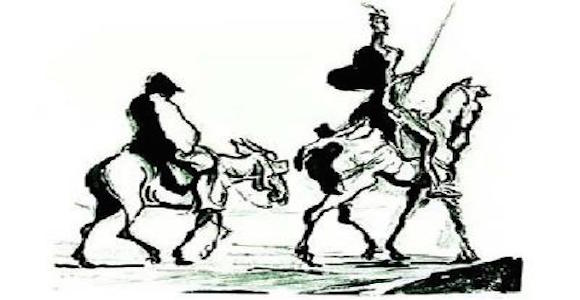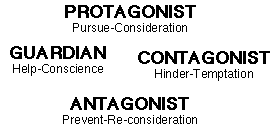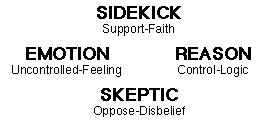Excerpt from an early, unpublished draft of the Dramatica Theory Book. Many of these concepts were not included in the version eventually published:
To make an argument that a particular element is or is not a solution to a particular problem, Character make-up must remain consistent throughout the story.
In order for the argument of a story to be complete, all approaches to solving a problem must be represented. This is the purpose of Characters. Each Character illustrates one or more ways in which one might address a problem. These different approaches are commonly referred to as Character Traits. We call them Character Elements.
If we think of the traits as elements, we can imagine that the chemical compounds created by various combinations can lead to an extraordinary number of different “substances”, or personalities from a relatively small number of building blocks.
Picture the Author as Chemist, filling several jars with samples from a rack of elements. She might put a single element in one jar but a number of them in another. Depending upon the selections she makes, a given jar might grow cold or boil, turn red or blue, crystallize or form polymers.
Now suppose this Author/Chemist was operating under laboratory guidelines that she must use each chemical element off the shelf, but only once – in only one jar. It is conceivable she might put them all into a single jar, but what a mess it would be, trying to determine which element was responsible for which effect. The interactions would become muddled beyond understanding.
Certainly, in a story, such a hodgepodge would fail to fulfill the mandate of making a full and meaningful argument. No, if we are to cover the field, but not at the expense of clarity, we must examine the interactions of smaller groups of elements, which calls for several more jars.
Obviously, if we used a separate jar for each element, nothing would react at all, which means to an author that virtually all of the conflict within Characters would be lost with only the potential of conflict between Characters remaining. Certainly each element could be fully understood, and indeed, from time to time, an author may find good reason to keep a few Character elements solo, so that they might be absolutely defined. More often, however, it serves the story better to combine more than one element in more than one jar.
In this way, very specific combinations can be fully explored, and not at the expense of clarity.
Each of the Character Elements must be employed in one character or another. None must be left out. Otherwise the argument of the story will have a hole in it. None must be represented in more than one Character, otherwise the argument will be redundant, confusing, and become less interesting.
Even within these guidelines, a huge number of different types of Characters can be created. Yet, in many stories, we see the same Characters appearing over and over again. Characters like the Hero and the Villain and the Sidekick recur in a plethora of stories in a multitude of genres. This is not necessarily due to a lack of creativity by these authors. Rather, of all the elements, there is one central arrangement that is something like an alignment of the planets. It is a point of balance where each Character looks exactly like the others, only seen through a filter – or with different shading.
Characters made in this special alignment are called Archetypal. Out of all the myriad of ways in which Elements could be arranged, there is only one arrangement that is Archetypal. Is this good or is this bad? For the author who wants to explore Character nuances, Archetypal Characters are probably a poor choice. But for the author who wants to concentrate on Action, it may be a very prudent choice.
It should be noted that just because a Character is Archetypal, does not mean she is a stick figure. Archetypal Characters contain the full complement of elements that any other Character might have. It is the arrangement of these so that all Elements of a like kind make up a single Character that simplifies the complexity of the interactions between Characters. This un-clutters the field and allows for more attention to be paid to other areas such as action, if that is the Author’s intent.
In our example of the Author/Chemist, the jars she uses fulfill an essential purpose: they keep the Chemical compounds separate from one another. That is the function and definition of Character:
A Character is a unique arrangement of solely possessed elements that does not vary over the course of the story.
The last few words above are italicized because the stability of the arrangement of elements is essential to identifying a Character. If elements could swap around from Character to Character, the story would lose its strength of argument, since an approach begun by one Character might only be shown to succeed or fail in another.
When we, as audience, watch a story, we hope to learn that we should or should not use a particular approach, so that we may grow from that experience in our own lives. But how can that point be made if a Character does not finish what she starts. We may see the element as failing, but the argument is left open that perhaps if only the Character who started with that element had stuck with it she would have succeeded.
Players
What about Jekyl and Hyde? Is that not an inconsistent Character? Yes, it is not. This is because Jekyl and Hyde are two different Characters. Two Characters in a single body? Exactly.
There is a great difference between a Character and the body it inhabits. We have all seen stories about spiritual possession, split personalities, or Sci-Fi personality transfers. In each of these instances, different Characters successively occupy the same body or physical host. We call these hosts Players.
A Player is a host in which a Character Resides
A Player does not have to be a person. It can be an animal, spiritual force, a car, a toy – anything that can be shown to possess a personality. Character is the personality, Player is where it resides. So, Jekyl and Hyde are two separate Characters who vie for the same Player’s body.
Conclusion to Objective Characters
We have now defined all of the elements or traits that can be combined to create Characters. We have also arranged these traits in meaningful groupings. We have described methods and rules governing the combining process. And, we have related each aspect of the Character Structure concept to the other aspects.
But something is missing. So far we have created a Structure, but it is a static Structure. We have not at all discussed the manner in which Characters interrelate and conflict. In effect, we have not created a set of Dynamics to drive the Structure.
As you may have noted, the Section headings of this book are divided into Structure and Dynamics, indicating that all Structural considerations will be explored before they are put into motion. There is a reason for this. When we had first completed discovering the sixty-four elements of Character, and had arranged them in the Author’s perspective, we thought that Character conflict would be the next door that opened to us. It was not. Try as we might, we could not perceive any kind of definable pattern that governed the interactions among Characters or even Character traits.
Instead, we found something most unexpected: that there was a definitive relationship among the structures of Character, Theme, Genre, and Plot. In fact, Plot did not just describe the Dynamics of Character, but Theme and Genre as well. So to see the Plot operation of Character conflict, Theme progression, and Genre perspectives, we first needed to finish our Structural model of Story, by building a Structure for Theme and Genre as well. Once this was accomplished we would then be able to discern and quantify the functioning of story Dynamics.
Therefore, we move on to the next set of bricks in our DRAMATICA Structure, edging ever closer to that elusive overview.





